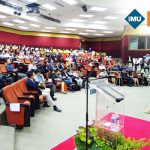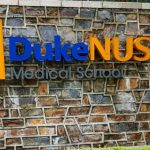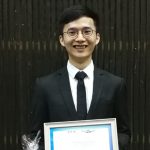From 15 April to 28 April 2024, we (IMU’s pharmacy students from cohort BP121) had the privilege of completing an elective placement at Linkou Chang Gung Memorial Hospital (CGMH) in Taiwan. CGMH is recognised as one of the largest medical institutions in Taiwan. This hospital offers comprehensive healthcare services, accommodating nearly 4,000 beds and dispensing approximately 5,000 outpatient prescriptions daily, making it the most profitable hospital in the country.
The 14-day experience of elective placement was designed to deepen our understanding of a pharmacist’s responsibilities in a hospital setting, enhance our knowledge of Taiwan’s healthcare system, and provide hands-on experience in patient care and safe medication administration. These objectives shaped a highly educational and transformative experience for us.
During our placement, we rotated through the inpatient and outpatient pharmacy departments, divided into five distinct sections: Medication Consultation, Inpatient Pharmacy Injection Department, Inpatient Pharmacy Inventory Department, Inpatient Medication Review, and Outpatient Pharmacy. Our group of 14 students was split into two smaller groups of seven, providing a more focused and hands-on experience.


Medication Consultation
In this department, we observed the critical processes of medication order review, interdisciplinary collaboration, and patient education. Pharmacists work closely with physicians and nurses to ensure safe medication management and provide essential information on dosage, administration, and side effects to patients. We have gained invaluable insights by observing a qualified pharmacist in patient medication counselling. The department’s emphasis on patient care and safety highlighted the crucial impact of pharmacists in optimising medication use and treatment outcomes.
Inpatient Pharmacy Injection Department
Here, we learnt about the preparation and administration of injectable medications, including antibiotics, parenteral nutrition, saline solutions, insulin pens, and vaccines. The department’s efficiency and safety measures, such as a smart medication finder system and automated dispensing cabinet as illustrated in Figure 1 and 2 that reduce medication errors, were particularly impressive. This technology-enhanced workflow highlights the commitment of the hospital to patient safety and innovative healthcare solutions.

Smart Medication Finder System

Automated Dispensing Cabinet
Inpatient Pharmacy Inventory Department
This department focused on the meticulous management of medication inventory. We participated in daily tasks such as checking returned medication quantities, restocking, and packing medications for the wards. The high patient demand environment and the importance of accurate and timely medication delivery emphasised the critical role of inventory management in ensuring patient safety and operational efficiency.
Inpatient Medication Review
Led by senior pharmacists, this section involved reviewing doctors’ prescriptions to ensure patient safety. Although our role was observational, we learned about prescription screening protocols and the management of COVID-19 patients. Exposure to essential drug referencing platforms, such as the Sanford Guide and UpToDate, provided us with valuable resources for clinical practice. We were also impressed by the hospital’s databases, which are equipped with comprehensive information on medication indications, dosages, side effects, interactions and prices.
Outpatient Pharmacy
The outpatient pharmacy was the busiest department, dealing with a high volume of patients daily. We assisted in packing medications based on prescriptions and interacted with patients at the dispensing counter. The use of a conveyor belt system to streamline the workflow was particularly intriguing.
Moreover, the use of computerised medication bags significantly enhances the accuracy and efficiency of medication packaging and dispensing. These advanced systems improve the process, reducing the likelihood of errors and ensuring that medications are correctly labelled and dosed. Additionally, they provide patients with clear, detailed instructions on how to use their medications properly, which improves adherence to treatment regimens and overall health outcomes. This experience highlighted the importance of accuracy and efficiency in a fast-paced environment and provided insights into patient interactions and medication counselling.

Beyond our hands-on experiences, we attended several informative briefing sessions on topics such as Non-Tuberculosis Mycobacteria (NTM) infection management, geriatric fracture management, insomnia management, and the safety profile of antimicrobial agents, specifically fluoroquinolones. These sessions broadened our understanding of various healthcare issues and the role of pharmacists in managing them. The inter-professional case discussions demonstrated the collaborative efforts of healthcare teams in delivering optimal patient care. It also promotes a sense of unity and shared responsibility among healthcare professionals to improve patient outcomes.
Our elective placement at Linkou Chang Gung Memorial Hospital was an enlightening journey that deepened our understanding of hospital pharmacy practice. The hands-on experiences, coupled with the opportunity to observe different healthcare systems, have significantly broadened our perspective. We have gained valuable insights into medication dispensing, inventory management, and patient care, all of which are crucial for our future career as a pharmacist.

This experience also highlighted the importance of teamwork and effective communication in healthcare. Working alongside nurses, doctors, and other healthcare professionals, we witnessed the collaborative efforts required to provide the best patient care. Additionally, the placement emphasised the need for continual learning and adaptation in the fast-paced field of pharmacy.
The advanced technology in pharmacy is pivotal in this environment, it not only enhances efficiency but also improves accuracy and patient safety. These innovations ensure that pharmacists can manage high workloads while maintaining a high standard of care.
In addition, we observed that pharmacists are responsible for all aspects of medication preparation and distribution, from compounding and dispensing to ensuring patient safety and compliance with medical protocols. However in Malaysia, there are pharmacy technicians that assist with these tasks. The absence of pharmacy technicians means that pharmacists must handle a higher volume of tasks, which underscores their expertise and dedication. Interestingly, the head pharmacist mentioned that they are trying to integrate the pharmacy technician role into their system as this allows pharmacists to focus more on clinical duties and patient care while delegating routine tasks to technicians. This shift promises to enhance the efficiency of the pharmacy services, ultimately improving patient outcomes and the overall healthcare experience.
In summary, our placement at CGMH has been an enriching experience that has provided us with essential skills, knowledge, and perspectives. It has reinforced our commitment to patient-centred care and ongoing professional development, preparing us for the challenges and opportunities ahead in our pharmacy career.

Finally, we want to express our heartfelt thanks to the university for the support and guidance throughout this experience. It has truly been an honour and a privilege to represent our university on this transformative journey.
Participating Students in this Programme:
Ng Xin Rui
Joyce Nguang Siew Ngiik
Teo Mong Jie
Tan De Yuan
Chai Ying Hui
Candice Lau Yi Xin
Elaine T’en Yi Leng
Chan Jing Xiang
Teoh Kher Min
Teh Hao Yin
Lim Sing Yuk
Choo Shin Yi
Koo Jun Wei
Leslie Chieng Zheng Yue









